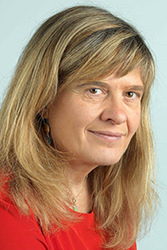Keynote: Ghislaine Dehaene-Lambertz
Thursday, November 9, 4:00 – 5:00 pm
Chesapeake Ballroom
Speaker: Ghislaine Dehaene-Lambertz, Pediatrician, Director of the Developmental Brain Imaging Lab, INSERM U992, Neurospin/CEA, Paris-Saclay, France
Chair: Patti Adank, University College London
Ghislaine Dehaene-Lambertz and her team investigate the development of cognitive functions in infants and children using brain imaging techniques. Their goal is to understand how complex cognitive functions, such as language, music, mathematics, etc… emerge in the human brain, thanks to a thorough description of the brain initial structural and functional organization. She published pioneering work using high-density event-related potentials (Nature 1994), functional resonance magnetic imaging (Science 2002) or optical topography (PNAS 2003-2013) to study language acquisition, and the neural signatures of consciousness (Science 2013) in the infant brain. She is the recipient of several national and international awards (Prix Justine and Yves Sergent 2013, Grand Prix Scientifique de la Fondation de France, 2015, et de L’Institut de France, 2016 ).
The human infant brain: A neural architecture able to learn language
Although different human languages use different sounds, words and syntax, most children acquire their native language without difficulties following the same developmental path. Once adults, they use the same specialized networks, located primarily in the left hemisphere around the sylvian fissure, to process speech. Thanks to the development of brain imaging, we can now study the early functional brain organization and examine on which cerebral resources, infants rely to learn their native language. Although these studies are still sparse, several characteristics are noticeable: first, parallel and hierarchical processing pathways are observed before intense exposure to speech with an efficient temporal coding in the left hemisphere and, second, frontal regions are involved from the start in infants ’ cognition. These observations are certainly not sufficient to explain language acquisition but illustrate a new approach that relies on a better description of infants ’ brain activity during linguistic tasks, which compared to results in animals and human adults should clarify the emergence of language in the human species.
